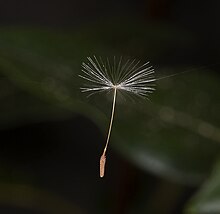Biologia disiĝo

Multi tool use

Proventa disiĝo de semoj de taraksako.
Biologia disiĝo aludas al movoj de specioj for el ekzistinta populacio aŭ el la patra organismo. Kvankam simple moviĝanta el unu habitata areeto al alia, la disiĝo de individuo havas konsekvencojn ne nur por individua taŭgeco, sed ankaŭ por la populacia dinamiko, la populacia genetiko, kaj la specia distribuado.[1][2][3] Kompreno de la disixgo kaj de la konsekvencoj kaj por evoluaj strategoj ĉe specinivelo, kaj por procezoj ĉe ekosistema nivelo, postulas komprenon pri la tipo de disiĝo, la disiĝa teritorio de preciza specio, kaj pri la disiĝaj mekanismoj uzitaj.
Biologia disiĝo povas esti kontrastata kun geodisiĝo, kio estas mikso de antaŭe izolaj populacioj (aŭ tute biotoj) sekve de la erozio de geografiaj baraĵoj por disiĝo aŭ genfluo (Lieberman, 2005;[4][5]Albert kaj Reis, 2011[6]).
Enhavo
1 Tipoj de disiĝo
2 Disiĝaj teritorioj
3 Disiĝaj mekanismoj
4 Notoj
5 Bibliografio
6 Eksteraj ligiloj
Tipoj de disiĝo |
Disiĝaj teritorioj |
Disiĝaj mekanismoj |
Notoj |
↑ Dunning, J. B. J., Stewart, D. J., Danielson, B. J., Noon, B. R., Root, T. L., Lamberson, R.H. & Stevens, E. E. (1995). Spatially explicit population models: current forms and future uses. Ecological Applications
↑ Hanski, I. & Gilpin, M. E. (eds.) (1997). Metapopulation biology : ecology, genetics and evolution, Academic Press, San Diego.
↑ HANSKI, I. (1999). Metapopulation Ecology, Oxford University Press, Oxford.
↑ Lieberman, 2005. Geobiology and paleobiogeography: tracking the coevolution of the Earth and its biota. Palaeogeography, Palaeoclimatology, Palaeoecology 219: 23-33
↑ http://www.sciencedirect.com/science/article/pii/S0031018204005887
↑ (8a Marto 2011) Historical Biogeography of Neotropical Freshwater Fishes. University of California Press. ISBN 978-0-520-26868-5.
Bibliografio |
- Ingold, C. T. (1971) Fungal spores: their liberation and dispersal Oxford, Clarendon Press 302 p. ISBN 0-19-854115-5
- Lidicker, W. Z. and R. L. Caldwell (1982) Dispersal and migration Stroudsburg, Pa. : Hutchinson Ross Pub. Co 311 p. ISBN 0-87933-435-5 (Dispersal of animals)
- Bullock, J. M.; R. E. Kenward and R. S. Hails (editors) (2002) Dispersal ecology : the 42nd symposium of the British Ecological Society. Oxford, UK : Blackwell Science 458 p. ISBN 0-632-05876-5 (Animals and plants)
- Lieberman, B. S. 2008. Emerging syntheses between palaeobiogeography and macroevolutionary theory. Proceedings of the Royal Society of Victoria 120: 51-57.
- Turner M. G., Gardner R. H., O’Neill. 2001. Landscape Ecology: In theory and practice, pattern and process. New York (NY): Springer Science.
- Groom M. J., Meffe G. K., Carroll C. R. 2005. Principles of Conservation Biology. Sunderland (MA): Sinauer Associates, Inc. 793 p.
- Hanski, I. (1999). Metapopulation Ecology, Oxford University Press, Oxford.
- Hanski, I. & Gilpin, M. E. (eds.) (1997). Metapopulation biology : ecology, genetics and evolution, Academic Press, San Diego.
- Levin, S. A. 1974. Dispersion and Population Interactions. The American Naturalist. 108:960, p. 207.
- Clobert, J., E. Danchin, A. A. Dhondt and J. D. Nichols (eds.)(2001) "dispersal", Oxford University Press, Oxford.
- Cousens, R., C. Dytham, R. Law (2008), Dispersal in plants: a population perspective, Oxford University Press, Oxford
Eksteraj ligiloj |
- Frukta kaj sema disiĝoj, bildoj ĉe bioimages.vanderbilt.edu
- Interactive model of movement of plant species induced by climate change
Qn BZXxDqd9h6mS